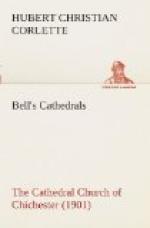Note.—For remarks on Chichester Cathedral, see Archaeologia, xvii., pp. 22-28: “Observations on the Origin of Gothic Architecture.” By G. Saunders, 1814.
[Illustration: TRANSVERSE SECTIONS FROM WILLIS’S ARCHITECTURAL HISTORY. North Aisle, original. (Scale 27 1/2 feet to 1 in.) South Aisle, as now existing.]
This process of reconstruction shows that the mediaeval builders did not restore in duplication of what had been lost. Where their work was destroyed they built anew and improved upon what had gone.
We need not suppose that this repair, renewal, and addition had all been completed when in 1199 Bishop Seffrid II. and six other bishops again consecrated the church. Doubtless only so much had been done as was necessary to enable the priests to officiate at an altar provided for the purpose and the congregation to assemble within the walls; for the work of building continued with a somewhat persistent manifestation of energy throughout the whole of the thirteenth century. Of this activity and enterprise there are many evidences in proof, both documentary and structural. The documentary evidence indicating the activity which prevailed after this date is sufficient to show at least that much was being done; but it does not often indicate in precise terms what is that particular portion of the building to which it primarily refers. Early in the thirteenth century (1207) the king gave Bishop Simon de Welles (1204-1207) his written permission to bring marble from Purbeck for the repair of his church at Chichester. He attached to this act of favour certain conditions which were to prevent any disposal of the material for other purposes.
John had also two years before given Bakechild Church to the “newly-dedicated” cathedral. Then Bishop Neville, or Ralph II. (1224-1244), at his death in 1244, “Dedit cxxx. marcas ad fabricam Ecclesiae et capellam suam integram cum multis ornamentis.” Walcott adds that “his executors, besides releasing a debt of L60 due to him and spent on the bell tower, gave L140 to the fabric of the Church, receiving some benefit in return.” This cannot be interpreted as referring to the isolated tower standing apart to the north of the west front; for, as we shall see,




